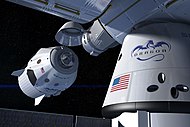Axiom Mission 3
| Axiom Mission 3 | |||
| Statistik för uppdraget | |||
|---|---|---|---|
| NSSDC-ID | 2024-014A[1] | ||
| Modell | Dragon 2 | ||
| Beställare | Axiom Space | ||
| Operatör | SpaceX | ||
| Farkostens namn | Freedom | ||
| Varaktighet | 21 dag, 15 tim, 41 min | ||
| Uppskjutning | |||
| Raket | Falcon 9 Block 5 | ||
| Uppskjutningsramp | Kennedy LC-39A | ||
| Uppskjutning | 18 januari 2024, 21:49 UTC[2] | ||
| Landning | |||
| Landning | 9 februari 2024, 13:30 UTC | ||
| Landningsplats | Atlanten | ||
| Omloppsbana | |||
| Grader | 51,6° | ||
| Dockning | |||
| Rymdstation | ISS | ||
| Dockning | 20 januari 2024, 10:15 UTC | ||
| Port | PMA-2/IDA-2 (Harmony, fram) | ||
| Ur dockning | 7 februari 2024, 14:20 UTC | ||
| Tid dockad | 18 dag, 3 tim, 38 min | ||
| Besättning | |||
| Befälhavare | Michael López-Alegría (6) | ||
| Pilot | Walter Villadei (2) | ||
| Uppdragsspecialister | Alper Gezeravcı (1) Marcus Wandt (1) | ||
 López-Alegría, Villadei, Gezeravcı, Wandt | |||
| Kronologi | |||
| |||
Axiom Mission 3 även känd som Ax-3 är uppdragsbeteckningen för den tredje privata bemannade rymdfärden med en Dragon 2-rymdfarkost från SpaceX till den Internationella rymdstationen (ISS). Flygningen beställdes av företaget Axiom Space. Farkosten sköts upp med en Falcon 9-raket från Kennedy Space Center LC-39A den 18 januari 2024.[2]
Flygningen, som tog ca 36 timmar, transporterade Michael López-Alegría, Walter Villadei, Alper Gezeravcı och Marcus Wandt till ISS dit de anlände den 20 januari [3] för en upp till 14 dagar lång vistelse ombord på rymdstationen.
Efter att flygningen fått förlängas några dagar, på grund av dåligt väder i landningszonen, lämnade farkosten, rymdstationen den 7 februari 2024. Två dagar senare återinträdde den i jordens atmosfär och landade i Atlanten utanför Floridas kust.
Besättning
| Befälhavare | Hans sjätte rymdfärd |
|---|---|
| Pilot | Hans andra rymdfärd |
| Flygingenjör 1 | Hans första rymdfärd |
| Flygingenjör 2 | Hans första rymdfärd |
Backup
| Befälhavare | |
|---|---|
| Flygingenjör 1 |
Se även
Källor
- ^ ”NASA Space Science Data Coordinated Archive” (på engelska). NASA. https://nssdc.gsfc.nasa.gov/nmc/spacecraft/display.action?id=2024-014A. Läst 11 februari 2024.
- ^ [a b] ”Axiom Mission 3” (på engelska). Next Spaceflight. 17 januari 2024. https://nextspaceflight.com/launches/details/6790. Läst 17 januari 2024.
- ^ ”Four Ax-3 Astronauts Board Station and Meet Expedition 70 Crew” (på engelska). NASA. https://blogs.nasa.gov/spacestation/2024/01/20/four-ax-3-astronauts-board-station-and-meet-expedition-70-crew/. Läst 21 januari 2024.
| |||||||||||
| ||||||||||||||||||||||||||||||||||||||||||||||||||||||||
| |||||||||||||||||||||||||||||||
| ||||||||||||||||||||||||||||||||
Media som används på denna webbplats
Författare/Upphovsman: Gutten på Hemsen, Licens: CC0
Flag of Norway with colors from the previous version on Commons. This file is used to discuss the colors of the Norwegian flag.
Axiom Mission 3 crew members Michael Lopez-Alegria, Walter Villadei, Alper Gezeravci, and Marcus Wandt docked to the forward port of the Harmony module of the International Space Station Jan. 20 following a launch from NASA’s Kennedy Space Center in Florida Jan. 18. Following docking, the crew opened the hatch of the SpaceX Dragon spacecraft and floated aboard the International Space Station where they were greeted by members of the Expedition 70 crew. The four private crew members will conduct a mission living and working aboard the microgravity laboratory on the third private astronaut mission as part of NASA’s effort to open to space to more people and science
In this illustration, a SpaceX Crew Dragon spacecraft approaches the International Space Station for docking. NASA is partnering with Boeing and SpaceX to build a new generation of human-rated spacecraft capable of taking astronauts to the station and expanding research opportunities in orbit. SpaceX's upcoming Demo-1 flight test is part of NASA’s Commercial Crew Transportation Capability contract with the goal of returning human spaceflight launch capabilities to the United States.
Författare/Upphovsman: SpaceX, Licens: CC0
This artist's concept shows a SpaceX Crew Dragon docking with the International Space Station as it will during a mission for NASA's Commercial Crew Program. NASA is partnering with Boeing and SpaceX to build a new generation of human-rated spacecraft capable of taking astronauts to the station and expanding research opportunities in orbit.
Författare/Upphovsman: Pascal (Flickr user: pasukaru76), Licens: CC0
Vostok spacecraft replica at the Technik Museum Speyer, Germany.
Backdropped by a blue and white Earth, this close-up view features the Soyuz TMA-6 spacecraft approaching the International Space Station (ISS). Onboard the spacecraft are cosmonaut Sergei K. Krikalev, Expedition 11 commander representing Russia's Federal Space Agency; astronaut John L. Phillips, NASA ISS science officer and flight engineer; and European Space Agency (ESA) astronaut Roberto Vittori of Italy. The Soyuz linked to the Pirs Docking Compartment at 9:20 p.m. (CDT) on April 16, 2005 as the two spacecraft flew over eastern Asia. The docking followed Friday’s launch from the Baikonur Cosmodrome in Kazakhstan.
Författare/Upphovsman: Space Exploration Technologies Corp., Licens: CC0
The 2018 version of the Big Falcon Rocket at stage separation: Starship (foreground) and Super Heavy (background)
Rotated and color enhanced version of original (ISS013-E-48788 (6 July 2006) --- The Space Shuttle Discovery approaches the International Space Station for docking but before the link-up occurred, the orbiter went through a series of inspection photos by station crew to inspect the vehicle for any damage to its Thermal Protection System. This was known as the Rendezvous Pitch Maneuver and was implemented after the Columbia Disaster in 2003. The Leonardo Multipurpose Logistics Module can be seen in the shuttle's cargo bay. Discovery docked at the station's Pressurized Mating Adapter 2 at 9:52 a.m. CDT, July 6, 2006.)


















